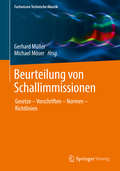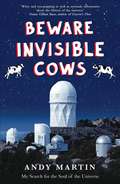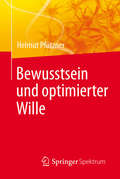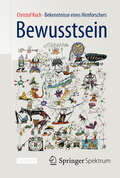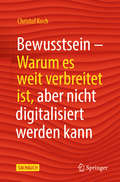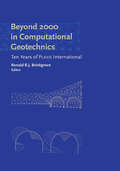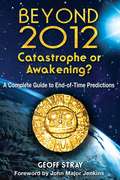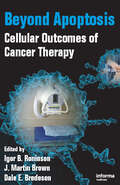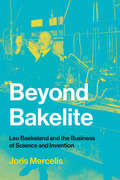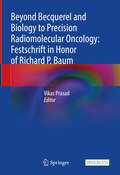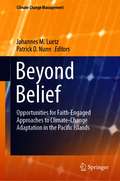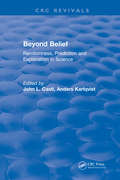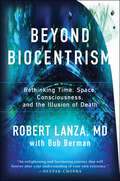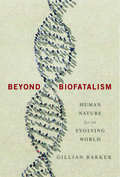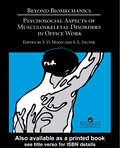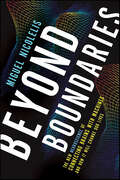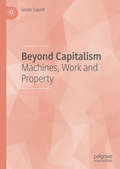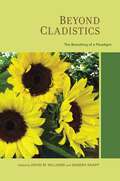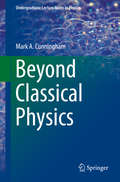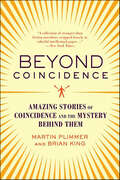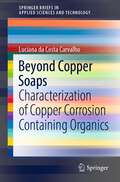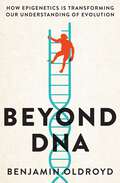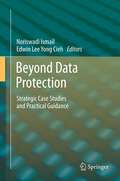- Table View
- List View
Beurteilung von Schallimmissionen: Gesetze – Vorschriften – Normen – Richtlinien (Fachwissen Technische Akustik)
by Michael Möser Gerhard MüllerDieser Band der Reihe Fachwissen Technische Akustik beschreibt das Ausmaß von Lärmwirkungen mit Hilfe objektivierbarer Einflussfaktoren. Die behandelten Themen dienen dazu, Aussagen zu treffen, ob angestrebte Schutzziele, wie z.B. die Vermeidung erheblicher Belästigungen oder die Gewährleistung einer guten Sprachverständlichkeit, erreicht werden.
Beware Invisible Cows
by Andy MartinWhat really happened at the moment of the Big Bang? And how the hell do we know? And why is finding out so important? And who are these people who design and build these experiments? And is it all worth it? Andy Martin sets out on a road trip to search for the soul of the universe. In his personal quest for the mother of all truths, he has to go all the way back to the origin of time and space. He climbs up to the highest observatory in the world and sticks his head inside a 4 km-long laser tube capable of surfing waves from the Big Bang. He sees himself the way he used to be in a mirror and he discovers where you go when you die. He has close encounters with aliens and intimations of immortality. This book has everything -- science, philosophy, literature, religion, Einstein, Weinstein, God, the Godfather, all seen through a glass darkly.
Bewegende Zeiten: Mobilität der Zukunft
by Julian WeberSitzen wir wirklich schon bald nicht mehr selbst am Steuer unseres Autos, sondern werden nur noch von fahrerlosen Elektro-Taxis ans Ziel gebracht? Sollen Städte Car Sharing einführen? Welche Rolle werden Elektroroller, Seilbahnen oder manntragende Drohnen in den Mobilitätssystemen der Großstädte spielen? Dieses Buch erklärt endlich allgemeinverständlich, was sich hinter Schlagworten wie Elektromobilität, autonomes Fahren, Digitalisierung und Mobilitätsdienstleistungen wie Car Sharing oder Ride Hailing wirklich verbirgt, wie weit fortgeschritten diese Technologien heute sind, und vor allem auch in welchen Beziehungen und Abhängigkeiten diese zueinander stehen. Dabei werden neben den technischen auch die gesetzgeberischen und gesellschaftlichen Trends betrachtet, die als wichtige Rahmenbedingungen die Mobilität der Zukunft maßgeblich mitbestimmen.Aus dem Inhalt• Mobilitätsbedarfe: Wer will alles wann, warum wohin – und wie wird sich das in Zukunft ändern?• Technologische Trends: Elektromobilität, Digitalisierung, Autonomes Fahren – was werden die Fahrzeuge der Zukunft können?• Car Sharing, Ride Hailing, E-Scooter oder doch öffentlicher Nahverkehr: Welche Alternativen zum eigenen Pkw wird es in Zukunft geben?• Politik und Gesellschaft: Wie werden sich die Rahmenbedingungen der Mobilität in Zukunft entwickeln?• Mobilität im Wandel: Was sollten wir tun, um uns auf die Zukunft vorzubereiten?
Bewusst oder unbewusst? (Erlebnis Wissenschaft)
by Heinz Georg SchusterWhat is consciousness? This is the main question asked by the author, Prof Schuster, a specialist in complex adaptive systems and evolution models. From a natural scientific viewpoint he seeks answers to such questions as: How does this process work? How is our consciousness functionally organized as an evolutionary control process? And what is the difference between us and animals? Based on the hypothesis that human consciousness mainly has large evolutionary benefits in social behavior, this book investigates in a fascinating way the anatomical fundamentals, the development of conscious thought in the course of evolution, the creation of the self-image, empathy and language. Further, the possible dangers of artificial consciousness are discussed, a threat posed, for example, by even more intelligent computers.
Bewusstsein und optimierter Wille
by Helmut PfütznerDas Fehlen freien Willens - so die Sorge der Dualisten - entwürdigt den Menschen. Der Text belegt das Gegenteil: das Fehlen macht den Menschen robust und verlässlich. Dazu entwirft das Buch ein auf schrittweise optimierenden Vorgängen basierendes biophysikalisches Iterations-Modell, das die elementaren Funktionen des Gehirns in konsequenter Weise interpretiert. Aus nüchterner Sicht der Biophysik ist es hohe Konzentration von spezifischen Neuronen, die das höchst physische Phänomen des Bewusstseins entstehen lässt. Voraussetzung dafür ist, dass "Vehemenz" des Denkens aufkommt. Bewusstsein ist kein Produkt der Evolution, sondern ein den Naturgesetzen a priori zugegebener Faktor. Der ist zwar beschreibbar, doch nicht erklärbar - ebenso wenig wie Magnetismus oder Gravitation. An die Stelle von ,,freiem" Willen rückt ,,optimierter" Wille: Das von Ererbtem und Erworbenem geprägte Ich bestimmt das Handeln und Denken in optimierter Weise, gemeinsam mit Einflüssen der Umwelt. p>
Bewusstsein: Bekenntnisse eines Hirnforschers
by Christof Koch Jorunn Wissmann Monika Niehaus-OsterlohWie kann Aktivität im Gehirn Gefühle auslösen? Wie kann "bloßes Fleisch" - so wird der Körper in Cyberpunkromanen oft abfällig genannt -- subjektives Empfinden hervorbringen? Oder allgemeiner gesagt: Wie kann etwas Physisches etwas Nichtphysisches, subjektive Zustände erzeugen? Ob es der Zahnschmerz ist, die Freude beim Anblick der eigenen Kinder oder der Geschmack eines edlen Weins, sie alle haben denselben Ursprung in der Aktivität von Nervengewebe, im Bewusstsein. Christof Koch forscht seit Jahren über das Thema Bewusstsein. In einer Art Bestandsaufnahme zeigt er den derzeitigen Stand der Forschung auf, an dem auch maßgeblich Wissenschaftler wie Francis Crick, Ned Block, David Chalmers, Stanislas Dehaene, Giulio Tononi und Wolf Singer mitgewirkt haben. Ihm erscheint nicht als Widerspruch, mit naturwissenschaftlichen, empirischen Methoden erklären zu wollen, wie Gefühle entstehen. Wir sind uns der meisten Dinge, die in unserem Kopf vorgehen, nicht bewusst. Koch postuliert, dass Zombies ohne Bewusstsein in weiten Teilen unser Leben steuern, auch wenn wir der festen Überzeugung sind, darüber selbst zu bestimmen. Seiner Meinung nach wird es gelingen, empfindungsfähige Maschinen zu bauen - er liefert eine erste Vorlage hierfür im Buch. Er reflektiert so diverse Aspekte wie die Unterscheidung zwischen Aufmerksamkeit und Bewusstsein, das Unbewusste, die Physik und Biologie des freien Willen, Hunde, den Ring der Nibelungen, den Glauben an einen persönlichen Gott und Traurigkeit. Kochs Buch ist mehr als ein wissenschaftlicher Überblick - es ist zudem Bekenntnis, Autobiographie und futuristische Spekulation.
Bewusstsein: Warum es weit verbreitet ist, aber nicht digitalisiert werden kann
by Christof KochBewusstsein – das weiter verbreitet ist als bisher angenommen – ist das Gefühl, lebendig zu sein, es ist kein Rechenvorgang und auch kein cleverer Trick. In diesem Buch liefert Christof Koch eine schnörkellose Definition des Bewusstseins als bewusstes Erleben, vom alltäglichsten bis zum außergewöhnlichsten – eben das Gefühl zu leben.Die Psychologie erforscht, welche kognitiven Vorgänge einer bewussten Wahrnehmung jeweils zugrunde liegen. Die Neurowissenschaft spürt den neuronalen Korrelaten des Bewusstseins im Gehirn nach, dem Organ des Geistes. Aber warum das Gehirn und nicht etwa die Leber oder ein anderes Organ? Wie kann das Gehirn, drei Pfund höchst erregbares Gewebe, ein Gegenstand im Universum, der denselben physikalischen Gesetzen gehorcht wie jeder andere Gegenstand, subjektives Erleben hervorbringen? Will man eine Antwort auf diese Frage finden, braucht man, so Koch, eine quantitative Theorie, die beim Erleben ansetzt und zum Gehirn fortschreitet. Im vorliegenden Buch umreißt der Autor eine solche Theorie, basierend auf der integrierten Informationstheorie. Koch beschreibt, wie die Theorie viele Fakten zur Neurologie des Bewusstseins erklärt und wie man mit ihrer Hilfe sogar ein in der Klinik einsetzbares Bewusstseins-Messgerät konstruiert hat. Die Theorie sagt voraus, dass viele, ja vielleicht alle Tiere das Leben in vielen Facetten erleben; Bewusstsein ist viel weiter verbreitet als allgemein angenommen. Entgegen der landläufigen Ansicht aber argumentiert Koch, dass programmierbare Computer kein Bewusstsein haben werden. Selbst ein perfektes Softwaremodell des Gehirns ist nicht bewusst – es simuliert lediglich Bewusstsein. Bewusstsein ist keine bestimmte Art von Rechenvorgang, es ist kein cleverer Trick. Bewusstsein ist Sein.reich mit dem Sachbuchprogramm waren.
Beyond 2000 in Computational Geotechnics
by Ronald B.J. BrinkgreveThis volume contains papers presented during the first international PLAXIS symposium. Topics covered include: general geo-technical aspects; tunnels and deep excavations, and education and research. This pack is meant for the user of the PLAXIS program, as well as engineers and researchers.
Beyond 2012: A Complete Guide to End-of-Time Predictions
by John Major Jenkins Geoff StrayAn illustrated, encyclopedic overview of the prophecies, calendars, and theories that indicate the year 2012 is a threshold of great change for humanity • Looks at the scientific and anthropological evidence for the rare galactic alignment due to occur in December 2012 • Sifts through the catastrophic theories to show what we might really expect in 2012 In December of 2012 the Mayan Calendar’s Great Cycle will come to an end. Opinion remains divided as to whether apocalyptic scenarios of worldwide destruction or utopian visions of a spiritually renewed humanity will prevail after this key date has passed. What is certain, however, is that a rare galactic alignment will occur, one so unique that it is found at the core of many wisdom traditions from around the globe. Geoff Stray has been collecting the vast amounts of data relating to the 2012 phenomena since 1982. Far from confining his research to the Maya, who provide the most prominent predictions indicating this date will herald significant changes for humanity, he has studied the prophetic traditions of other cultures--including the Tibetan, Chinese, Jewish, Ethiopian, and tribal cultures from around the globe--to show the kind of convergence of cosmic purposes happening along a number of parallel tracks. This book offers an extensive study of many modern theories, including Terence McKenna’s timewave zero and Maurice Cotterell’s sunspot research as well as anomalous phenomena such as near death experiences and crop circles. Sifting through all the scientific research and speculation that the year 2012 has inspired, Geoff Stray provides an encyclopedic look at what we might really expect on this pivotal date.
Beyond Apoptosis: Cellular Outcomes of Cancer Therapy
by Dale E. Bredesen Igor B. Roninson J. Martin BrownAddressing a major field of interest for oncologists, cell biologists, and other biomedical researchers, Beyond Apoptosis provides an overview of how different biological mechanisms of cell death, senescence and mitotic catastrophe stop the growth of tumor cells treated with anticancer agents.Written by internationally renowned contributors, this t
Beyond Bakelite: Leo Baekeland and the Business of Science and Invention (Lemelson Center Studies in Invention and Innovation series)
by Joris MercelisThe changing relationships between science and industry in the late nineteenth and early twentieth centuries, illustrated by the career of the “father of plastics.”The Belgian-born American chemist, inventor, and entrepreneur Leo Baekeland (1863–1944) is best known for his invention of the first synthetic plastic—his near-namesake Bakelite—which had applications ranging from electrical insulators to Art Deco jewelry. Toward the end of his career, Baekeland was called the “father of plastics”—given credit for the establishment of a sector to which many other researchers, inventors, and firms inside and outside the United States had also made significant contributions. In Beyond Bakelite, Joris Mercelis examines Baekeland's career, using it as a lens through which to view the changing relationships between science and industry on both sides of the Atlantic in the late nineteenth and early twentieth centuries. He gives special attention to the intellectual property strategies and scientific entrepreneurship of the period, making clear their relevance to contemporary concerns. Mercelis describes the growth of what he terms the “science-industry nexus” and the developing interdependence of science and industry. After examining Baekeland's emergence as a pragmatic innovator and leader in scientific circles, Mercelis analyzes Baekeland's international and domestic IP strategies and his efforts to reform the US patent system; his dual roles as scientist and industrialist; the importance of theoretical knowledge to the science-industry nexus; and the American Bakelite companies' research and development practices, technically oriented sales approach, and remuneration schemes. Mercelis argues that the expansion and transformation of the science-industry nexus shaped the careers and legacies of Baekeland and many of his contemporaries.
Beyond Becquerel and Biology to Precision Radiomolecular Oncology: Festschrift in Honor of Richard P. Baum
by Vikas PrasadThis open access book is written by world-renowned experts on radiomolecular precision oncology to celebrate the work, life, principles and ideology of Richard P Baum.It includes commentaries, reviews and some thought provoking novel ideas on radionuclide precision oncology, covering topics such as various aspects of theranostics and molecular radiotherapy like radiolabeled peptides, radiolabeled antibodies, dosimetry, and quality control as well as the diagnosis and treatment of specific tumor types. Featuring contributions by biologists, physicists, chemists, mathematicians, geneticists, and physicians from a range of specialties, this Festschrift is highly interdisciplinary and will be a valuable resource for future precision oncologists.
Beyond Belief: Opportunities for Faith-Engaged Approaches to Climate-Change Adaptation in the Pacific Islands (Climate Change Management)
by Johannes M. Luetz Patrick D. NunnThis interdisciplinary book explores the science and spirituality nexus in the Pacific Islands Region and as such makes a critical contribution to sustainable climate change adaptation in Oceania. In addition to presenting case studies, literary analyses, field projects, and empirical research, the book describes faith-engaged approaches through the prism of: • Context: past, present, and future prospects• Theory: concepts, narratives, and theoretical frameworks• Practice: empirical research and praxis-informed case examples• Doctrine: scriptural contributions and perspectives• Engagement: enlisting religious stakeholders and constituencies Comprising peer-reviewed works by scholars, professionals, and practitioners from across Oceania, the book closes a critical gap in the literature and represents a groundbreaking contribution to holistic climate change adaptation in the Pacific Islands Region that is scientifically sound, spiritually attuned, locally meaningful, and contextually compelling.
Beyond Belief: Randomness, Prediction and Explanation in Science
by John L. CastiHow can we predict and explain the phenomena of nature? What are the limits to this knowledge process? The central issues of prediction, explanation, and mathematical modeling, which underlie all scientific activity, were the focus of a conference organized by the Swedish Council for the Planning and Coordination of Research, held at the Abisko Research Station in May of 1989. At this forum, a select group of internationally known scientists in physics, chemistry, biology, economics, sociology and mathematics discussed and debated the ways in which prediction and explanation interact with mathematical modeling in their respective areas of expertise. Beyond Belief is the result of this forum, consisting of 11 chapters written specifically for this volume. The multiple themes of randomness, uncertainty, prediction and explanation are presented using (as vehicles) several topical areas from modern science, such as morphogenetic fields, Boscovich covariance, and atmospheric variability. This multidisciplinary examination of the foundational issues of modern scientific thought and methodology will offer stimulating reading for a very broad scientific audience.
Beyond Biocentrism: Rethinking Time, Space, Consciousness, and the Illusion of Death
by Bob Berman Robert LanzaBiocentrism shocked the world with a radical rethinking of the nature of reality. But that was just the beginning. In Beyond Biocentrism, acclaimed biologist Robert Lanza, one of TIME Magazine's "100 Most Influential People in 2014," and leading astronomer Bob Berman, take the reader on an intellectual thrill-ride as they re-examine everything we thought we knew about life, death, the universe, and the nature of reality itself. The first step is acknowledging that our existing model of reality is looking increasingly creaky in the face of recent scientific discoveries. Science tells us with some precision that the universe is 26.8 percent dark matter, 68.3 percent dark energy, and only 4.9 percent ordinary matter, but must confess that it doesn't really know what dark matter is and knows even less about dark energy. Science is increasingly pointing toward an infinite universe but has no ability to explain what that really means. Concepts such as time, space, and even causality are increasingly being demonstrated as meaningless. All of science is based on information passing through our consciousness but science hasn't the foggiest idea what consciousness is, and it can't explain the linkage between subatomic states and observation by conscious observers. Science describes life as a random occurrence in a dead universe but has no real understanding of how life began or why the universe appears to be exquisitely designed for the emergence of life. The biocentrism theory isn't a rejection of science. Quite the opposite. Biocentrism challenges us to fully accept the implications of the latest scientific findings in fields ranging from plant biology and cosmology to quantum entanglement and consciousness. By listening to what the science is telling us, it becomes increasingly clear that life and consciousness are fundamental to any true understanding of the universe. This forces a fundamental rethinking of everything we thought we knew about life, death, and our place in the universe.
Beyond Biofatalism: Human Nature for an Evolving World
by Gillian BarkerBeyond Biofatalism is a lively and penetrating response to the idea that evolutionary psychology reveals human beings to be incapable of building a more inclusive, cooperative, and egalitarian society. Considering the pressures of climate change, unsustainable population growth, increasing income inequality, and religious extremism, this attitude promises to stifle the creative action we require before we even try to meet these threats. Beyond Biofatalism provides the perspective we need to understand that better societies are not only possible but actively enabled by human nature. Gillian Barker appreciates the methods and findings of evolutionary psychologists, but she considers their work against a broader background to show human nature is surprisingly open to social change. Like other organisms, we possess an active plasticity that allows us to respond dramatically to certain kinds of environmental variation, and we engage in niche construction, modifying our environment to affect others and ourselves. Barker uses related research in social psychology, developmental biology, ecology, and economics to reinforce this view of evolved human nature, and philosophical exploration to reveal its broader implications. The result is an encouraging foundation on which to build better approaches to social, political, and other institutional changes that could enhance our well-being and chances for survival.
Beyond Biomechanics: Psychosocial Aspects Of Musculoskeletal Disorders In Office Work
by S. D. Moon S. L. SauterThere is now widespread recognition that psychosocial factors play a key role in the aetiology, perpetuation, management and prevention of cumulative trauma disorders CTDs. This text addresses the strength, direction and importance of links between psychosocial factors and CTDs.; The book's contributors examine critically current research data, ide
Beyond Boundaries: The New Neuroscience of Connecting Brains with Machines and How It Will Change Our Lives
by Miguel NicolelisA pioneering neuroscientist shows how the long-sought merger of brains with machines is about to become a paradigm-shifting realityImagine living in a world where people use their computers, drive their cars, and communicate with one another simply by thinking. In this stunning and inspiring work, Duke University neuroscientist Miguel Nicolelis shares his revolutionary insights into how the brain creates thought and the human sense of self—and how this might be augmented by machines, so that the entire universe will be within our reach.Beyond Boundaries draws on Nicolelis's ground-breaking research with monkeys that he taught to control the movements of a robot located halfway around the globe by using brain signals alone. Nicolelis's work with primates has uncovered a new method for capturing brain function—by recording rich neuronal symphonies rather than the activity of single neurons. His lab is now paving the way for a new treatment for Parkinson's, silk-thin exoskeletons to grant mobility to the paralyzed, and breathtaking leaps in space exploration, global communication, manufacturing, and more. Beyond Boundaries promises to reshape our concept of the technological future, to a world filled with promise and hope.
Beyond Capitalism: Machines, Work and Property
by Giulio SapelliThis book offers a new perspective on the financialisation of the economy and its profound technological transformation in an increasingly interdependent and globalised world. A deterioration of capitalist property has led to the reactivation of pre-capitalist social phenomena such as slavery. Meanwhile secular deflation and international destruction of the social state have wrought havoc with all familiar modern welfare infrastructure. Yet, Sapelli argues, there is still hope in the form of the gradual evolution of a community-based socialism based on diverse forms of ownership, co-operative living and working, and sustainable capitalist property. Sapelli presents a severe and dramatic look at the present world, where there is still a light at the end of the tunnel.
Beyond Cladistics: The Branching Of A Paradigm (Species And Systematics Ser. #3)
by Sandra Knapp David M. WilliamsCladistics, or phylogenetic systematics--an approach to discovering, unraveling, and testing hypotheses of evolutionary history--took hold during a turbulent and acrimonious time in the history of systematics. During this period--the 1960s and 1970s--much of the foundation of modern systematic methodology was established as cladistic approaches became widely accepted. Virtually complete by the end of the 1980s, the wide perception has been that little has changed. This volume vividly illustrates that cladistic methodologies have continued to be developed, improved upon, and effectively used in ever widening analytically imaginative ways.
Beyond Classical Physics (Undergraduate Lecture Notes in Physics)
by Mark A. CunninghamThis undergraduate textbook discusses the nature of the microscopic universe from a modern perspective, based on Einstein's notions of relativity and Noether's proof of the emergence of conservation laws from symmetries of the equations of motion. These ideas drove the development of the Standard Model of particle physics and subsequent attempts to define a unified (string) theory. The second half of the book explores various aspects of many-body physics, ranging from chemical systems to plasmas to black holes. Like the previous textbook authored by by Mark Cunningham, Neoclassical Physics, this text uses a guided discovery approach of instruction, highlighting the experimental results that drove development of our modern picture of subatomic physics. Many problems utilize Mathematica#65533; software to enable students to explore the meaning of different equations in a graphical manner. Students will gain an appreciation of the current state of physical theory, in preparation for more detailed, advanced study as upperclassmen.
Beyond Coincidence: Amazing Stories of Coincidence and the Mystery Behind Them
by Martin Plimmer Dr. Brian KingEver wonder what the odds are of being struck by lightning? Or winning the lottery? Or meeting someone from Timbuktu with the same middle name as you?BEYOND COINCIDENCE recounts and analyzes over 200 amazing stories of synchronicity, the likes of:Laura Buxton, age ten, releases a balloon from her back yard. It lands 140 miles away in the backyard of another Laura Buxton, also age ten.Two sisters in Alabama decide, independently, to visit the other. En route, their identical jeeps collide and both sisters are killed.A British cavalry officer was fighting in the last year of World War One when he was knocked off his horse by a flash of lightning. He was paralyzed from the waist down. The man moved to Vancouver, Canada where, six years later, while fishing in a river, lightning struck him again, paralyzing his right side. Two years later, he was sufficiently recovered to take walks in a local park when, in 1930, lightning sought him out again, this time permanently paralyzing him. He died soon after. Four years later, lightning destroyed his tomb.
Beyond Copper Soaps: Characterization of Copper Corrosion Containing Organics (SpringerBriefs in Applied Sciences and Technology)
by Luciana da CarvalhoThis book reports a series of electrochemical experiments where copper was corroded in the presence of various organic substances. Combining data from spectroscopy techniques, X-ray diffraction and mass spectrometry (including proteomics) the experiments demonstrate that copper-organic complexes can be formed during the corrosion of copper. The low solubility of copper-organic complexes in organic solvents and their amorphous nature mean that these compounds cannot be easily detected by one single analytical technique. This book benefits researchers investigating the presence of organic residues in archaeological copper corrosion and copper-organic complexes in art, where sampling is often subject to curatorial constraints.
Beyond DNA: How Epigenetics is Transforming our Understanding of Evolution
by Benjamin OldroydBeyond DNA is a journey through uncharted territory, advancing new ways of thinking about evolution and adaptation. For nearly a hundred years evolutionary biologists have understood that evolution proceeds by substituting better genes for less good ones. But consensus is growing that this is not the whole story: geneticists are now revealing that spores, sperm, pollen and ova are packed with personalised genetic information that plays an important role in offspring development and has lifelong effects. This epigenetic - or 'extra-genetic ' -inheritance therefore makes significant contributions to evolutionary processes. In this highly accessible book, packed with instructive examples, Benjamin Oldroyd explains how a greater appreciation of the role of epigenetics is helping to solve a multitude of previously intractable problems in evolutionary biology - puzzles as varied as why invasive plants and animals can rapidly adapt to changes in their environment, how worker bees and queen bees can develop from the same egg, and why cancer becomes more common as we age. Beyond DNA concisely explains the mechanisms that underlie epigenetics, shows how epigenetic processes can lead to adaptation, and speculates on meaty issues such as the role that epigenetics plays in human health and happiness.
Beyond Data Protection: Strategic Case Studies and Practical Guidance
by Edwin Lee Yong Cieh Noriswadi IsmailThe book deals with data protection issues from practical viewpoints. 40% of the content focus on the Malaysian Personal Data Protection Act (PDPA) 2010 progress, whilst 60% of the content focus on leading comparative practical guidance from Europe. Part of the PDPA provisions is mirrored from European approaches and practices. The approach of this book is straightforward, handy and readable and is supplemented by practical applications, illustrations, tables and diagrams. Practical examples highlighted in this book range from cloud computing, radio frequency identification technology, social media networks and information security to basic related aspects of data protection issues covering strategic leadership, management, governance and audit in businesses, organisations and local authorities. Recommended best practices have been outlined for practical guidance accompanied with future challenges and opportunities for Malaysia and ASEAN. The book is equally suitable for academics, practitioners, governmental officials and regulators dealing with data protection within their sector-specific legislation.
